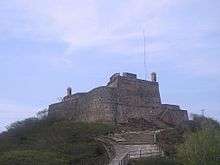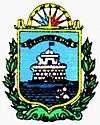Puerto Cabello
Coordinates: 10°28′00″N 68°01′00″W / 10.46667°N 68.01667°W
| Puerto Cabello | |||
|---|---|---|---|
| |||
 Puerto Cabello | |||
| Coordinates: 10°28′00″N 68°01′00″W / 10.46667°N 68.01667°W | |||
| Country | Venezuela | ||
| State | Carabobo | ||
| Counties | Puerto Cabello | ||
| Demonym | Porteño | ||
| Government | |||
| • Mayor | Economista Rafael Lacava Evangelista (2008 - 2012) | ||
| Area | |||
| • Total | 729 km2 (281 sq mi) | ||
| Population (2001) | |||
| • Total | 201.511 (INE, 2,010) | ||
| • Density | 276.42/km2 (715.9/sq mi) | ||
| Website | Alcaldía de Puerto Cabello | ||
Puerto Cabello (Spanish pronunciation: [ˈpweɾto kaˈβeʝo]) is a city on the north coast of Venezuela. It is located in Carabobo State, about 210 km west of Caracas. As of 2011, the city had a population of around 182,400. The city is home to the largest and busiest port in the country and is thus a vital cog in the country's vast oil industry. The word 'cabello' translates to 'hair'. The Spaniards took to saying that the sea was so calm there that a ship could be secured to the dock by tying it with a single hair.
Climate
| Climate data for Puerto Cabello | |||||||||||||
|---|---|---|---|---|---|---|---|---|---|---|---|---|---|
| Month | Jan | Feb | Mar | Apr | May | Jun | Jul | Aug | Sep | Oct | Nov | Dec | Year |
| Average high °C (°F) | 30 (86) |
29 (85) |
30 (86) |
30 (86) |
31 (87) |
31 (87) |
31 (87) |
31 (88) |
32 (89) |
31 (88) |
30 (86) |
30 (86) |
31 (87) |
| Average low °C (°F) | 22 (72) |
22 (72) |
23 (73) |
23 (74) |
23 (74) |
23 (74) |
24 (75) |
23 (74) |
24 (75) |
25 (77) |
24 (75) |
23 (74) |
23 (74) |
| Average precipitation mm (inches) | 99 (3.9) |
33 (1.3) |
10 (0.4) |
43 (1.7) |
89 (3.5) |
80 (3) |
109 (4.3) |
99 (3.9) |
64 (2.5) |
61 (2.4) |
94 (3.7) |
104 (4.1) |
881 (34.7) |
| Source: Weatherbase [1] | |||||||||||||
History

Puerto Cabello's location made it an easy prey to buccaneers and was a popular trading post for Dutch smugglers during the 17th century. Most of the contraband trade consisted of cocoa with neighboring island Curaçao, colonized by the Dutch. Puerto Cabello was also at that time under Dutch control.
It was not until 1730 that the Spanish took over the port, after the Real Compañía Guipuzcoana had moved in. This company built warehouses, wharves and an array of forts to protect the harbor.
During the War of Jenkin's Ear, Puerto Cabello was the careening port of the Company, whose ships had rendered great assistance to the Spanish navy in carrying troops, arms, stores and ammunition from Spain to her colonies, and its destruction would be a severe blow both to the Company and the Spanish Government. The commodore Charles Knowles at command of the 70-gun HMS Suffolk in 1743 received orders to carry out attacks on the Spanish settlements at Puerto Cabello and La Guaira. The Spanish governor Gabriel de Zuluaga, well informed of the plans, recruits extra defenders and were supplied with gunpowder by the Dutch. Consequently, an attack on La Guaira, on 18 February 1743, the English fleet was beaten off by the defenders. Knowles withdrew his force and refitted at Curaçao before attempting an assault on Puerto Cabello on 15 April, and again on 24 April, but both assaults were beaten back. Knowles called off the expedition and returned to Jamaica.
By the 1770s Puerto Cabello came to be the most fortified town on the Venezuela’s coast. The San Felipe castle and the Solano fortress remain from the period. The frigate Santa Cecilia (former HMS Hermione), under the command of Captain Don Ramon de Chalas, sat in Puerto Cabello until Captain Edward Hamilton, aboard HMS Surprise cut her out of the harbour on 25 October 1799. The Spanish casualties included 119 dead; the British took 231 Spaniards prisoner, while another 15 jumped or fell overboard. Hamilton had 11 men injured, four seriously, but none killed. Hamilton himself was severely wounded.
The forces of the First Republic of Venezuela briefly held San Felipe castle. In 1812 Simón Bolívar, then a colonel in the independist forces, was appointed commandante of Puerto Cabello. He left after a royalist rebellion broke out. In 1821 the Spanish retreated to the castle after their defeat at the decisive Battle of Carabobo.
Puerto Cabello was the last Spanish royalist stronghold during Venezuela’s war for independence, it was captured by José Antonio Páez on 8 November 1823. The harbour came under Anglo-German attack in the Venezuela Crisis of 1902-1903 and according to press reports was left in ruins.
In 1962, Puerto Cabello was the site of an uprising, known as El Porteñazo, by pro-Fidel Castro naval officers, marines, and members of the FALN. Although loyalist naval forces were able to quickly take back the base and arrest the rebels, they were unable to prevent the marines from occupying the city and arming pro-Castro forces. Despite ambushes and bloody house-to-house fighting, loyal National Guard and mechanized regular forces were able to retake Puerto Cabello.[2]
Tourism
.jpg)
Puerto Cabello has exhibited strong tourist potential and has been shown to have a local, growing tourist industry, this is mainly because of its position as the main trading area in the country, its communications, its rich historic heritage and its location on the Caribbean Sea.
The streets of the Colonial ages preserve their rustic and picturesque appearance, with their beautiful households and mansions and the cobblestone paving on the streets, all these features make the city a nice and growing tourist destination.
At the jetty, one can see the Caribbean Sea, as well as the massive Fortín de San Felipe, also known as the Castillo del Libertador, this mighty fort worked as a refuge for citizens during the Colonial times, because pirates invaded the city constantly.
Attractions
- Protestants Graveyard.
- Solano Fortress (part of the San Esteban National Park)
- San Felipe Castle.
- Long Island.
- Puente de Los Españoles (San Esteban Pueblo).
- Teatro Municipal
Natives
- Carlos Zambrano, professional baseball player for the Miami Marlins, was born here.
- Pablo Sandoval, professional baseball player for the Boston Red Sox, was born here.
- Fernando Nieve, professional baseball player for the New York Mets, was born here.
- Victor Moreno, professional baseball player, was born here.
- Félix Doubront, professional baseball player for the Chicago Cubs, was born here.
- Willson Contreras, professional baseball player for the Chicago Cubs, was born here.
- Bartolome Salom, militar, heroe of independence war.
Transport
Puerto Cabello is served by a station on the Instituto de Ferrocarriles del Estado network.
Industry
The UCOCAR shipyards are in Puerto Cabello, and have been awarded contracts to construct patrol vessels for the Venezuela Coast Guard.[3][4]
See also
References
- ↑ "Weatherbase: Historical Weather for Puerto Cabello, Venezuela". Weatherbase. 2011. Retrieved on November 24, 2011.
- ↑ "Venezuela: Siege of Puerto Cabello". The New York Times. June 15, 1962. Retrieved 28 December 2009.
- ↑ Armando F. Mastrapa III (2012-01-11). "Cuba & Venezuela will jointly build coastal patrol boats". Cubapolidata. Retrieved 2012-02-02.
An agreement has been signed between the Venezuelan Defense Ministry and Cuban Transportation Ministry to jointly build patrol boats for the Venezuelan Navy in Puerto Cabello (Carabobo), announced Admiral Diego Alfredo Molero Bellavia (Commander General, Venezuela Navy).
mirror - ↑ "JDW 10-Jan-2012 Venezuela, Cuba sign patrol craft accord". Jane's. 2012-01-10. Retrieved 2012-02-02.
The Venezuelan Ministry of Defence and the Cuban Ministry of Transport on 5 January signed an agreement under which Cuban technicians will assist in production of coastal patrol craft production at Venezuela's UCOCAR Navy shipyard.
mirror
External links
| Wikimedia Commons has media related to Puerto Cabello. |

